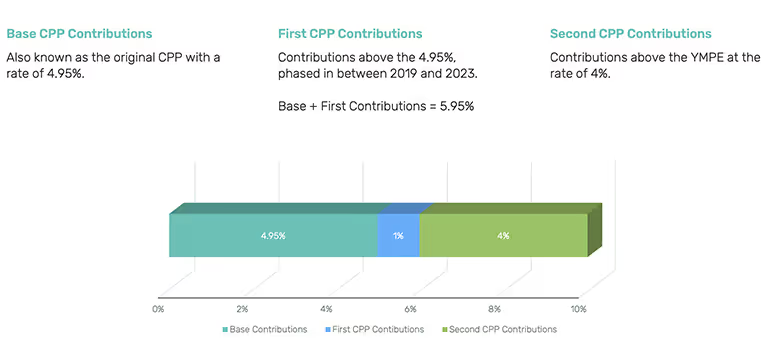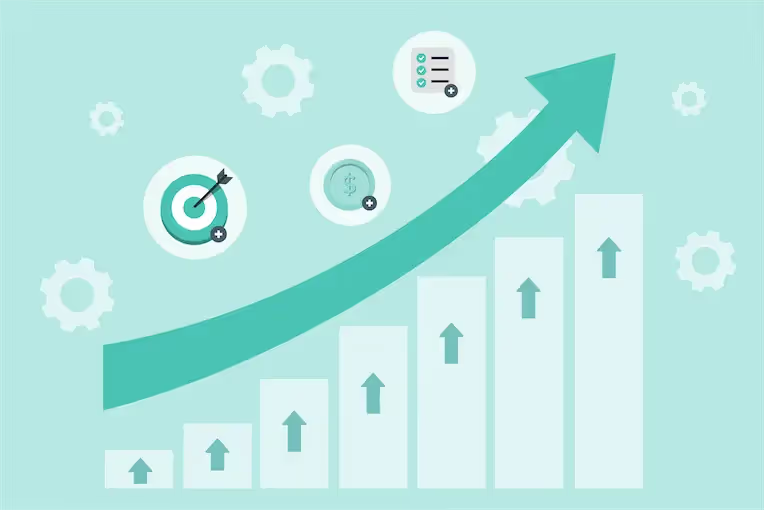What you need to know about the CPP enhancement
This year-end marks the first time enhanced CPP and QPP contributions must be balanced on tax slips. After setting up deduction codes earlier this year, now is the time to review and ensure accuracy for seamless year-end processing.
As of 2019, the Canada Pension Plan (CPP) is gradually being enhanced. This means that today’s workers, the seniors of tomorrow, will have higher benefits and greater financial stability through a small increase in the amount they contribute to the CPP.
Here is a full breakdown and explanation of the new CPP Enhancement (eCPP), what you can expect for 2024, and how to master the new CPP calculations. The information in this post is based on a recent webinar presented by the Canada Revenue Agency (CRA). If you have any additional questions, please reference the CRA or National Payroll Institute (NPI) for more information.
An overview of CPP enhancement benefits
Once fully in place in 2064, the CPP enhancement will increase the maximum CPP retirement benefit by about 50 percent. The current maximum benefit is $15,679. Today, the enhanced CPP represents an increase of nearly $8,000, to a maximum benefit of nearly $23,832.
Enhanced benefits will accumulate gradually as individuals pay into the enhanced CPP. Young Canadians just entering the workforce will see the largest increase in benefits. Canada Pension Plan income replacement levels will go from replacing 25% of a worker's pensionable earnings to 33%.
To fund these enhanced benefits, annual CPP contributions have increased modestly and will continue to increase until 2025. We’ll go over how these increases work in detail below.
Recap of CPP changes from 2019 to 2023
CPP saw rates increase incrementally from 4.95% in 2019 to 5.95% in 2023. This included the introduction of tax deductions for enhanced contributions.
- Contributions based on the 4.95% contribution rate are considered base contributions and result in a non-refundable tax credit which is applied during an employee's annual tax return.
- Contributions greater than the 4.95% contribution rate are considered enhanced contributions and are tax-deductible, meaning that when the pay is processed there is a reduction to pensionable earnings.
Let’s run through a quick scenario illustrating how that works in practice. Jane contributes $2,200 per year to the Canada Pension Plan. Of that, $1,830 will be a base contribution and the remaining $370 will be considered an enhanced contribution.

eCPP 2023 and beyond
On November 1, 2023, the CRA announced the maximum pensionable earnings and contributions for 2024.
Year’s Maximum Pensionable Earnings (YMPE) & Year’s Additional Maximum Pensionable Earnings (YAMPE)
The Year’s Maximum Pensionable Earnings (YMPE) determines the maximum amount on which CPP contributions are calculated.
Starting in 2024:
- YMPE will be referred to as the first earning ceiling
- The maximum pensionable earnings under CPP will be $68,500, up from $66,600 in 2023
- The basic exemption amount for 2024 remains at $3,500
- Year’s Additional Maximum Pensionable Earnings (YAMPE) will be referred to as the second earning ceiling
- YAMPE will be the new limit up to which earnings are considered pensionable
- Starting in 2024, a higher, second earnings ceiling of $73,200 will be implemented and used to determine second additional CPP contributions (CPP2). As a result, pensionable earnings between $68,500 and $73,200 are subject to CPP2 contributions.
- The second earning ceiling will be 7% higher than the first earning ceiling in 2024; then 14% higher in 2025, where it will remain at this level for the foreseeable future
Second CPP Contributions
Second CPP contributions will have a different contribution rate. This new rate will be 4% for employees and employers, and 8% for self-employed individuals.
Starting in 2024:
- Base CPP Contributions: Also known as the original CPP with a rate of 4.95%
- First CPP Contributions: Contributions above the 4.95%, phased in between 2019 and 2023.
- Base + First Contributions = 5.95%
- Second CPP Contributions: Contributions above the YMPE at the rate of 4%.

Please note: In 2024 there will be an additional T4 box for all Second CPP Contributions. This box will be 16A.
Examples of Second CPP Contributions
Let's take a look at some examples of the second CPP contributions in practice.
Tax treatment of CPP contributions for employers
Enhanced CPP and QPP Setup Guide
You can get a head start on the second phase of the enhanced CPP and QPP introduced for the 2024 payroll year. Check out this Help Centre article to set up your Avanti system for the changes and prepare for the new year.
Frequently Asked Questions
Q: Will the Box 16A amounts be deducted from the default 501, or will we add a second CPP code?
A: Everyone must create new deduction codes for the second CPP and QPP contribution. But don’t worry; we have a workshop scheduled to assist you in setting up these new codes well ahead of the upcoming year. Stay tuned for further information in your inbox.
Q: Has CRA officially announced/confirmed the YMPE and YAMPE numbers yet?
A: Yes, as of November 1, 2023, the CRA has announced the YMPE and YAMPE numbers for 2024, and you can find them here.
Q: How will the eCPP be handled on a biweekly payroll? Here, we only see the yearly calculations.
A: The second CPP will calculate based on YTD amounts using the YMPE and YAMPE. It won’t begin calculating the second CPP until the first YMPE ceiling is met.
Q: Does the eCPP deduction start from pay period 1 based on annual salary (i.e. if an employee’s annual salary is less than YAMPE, will Avanti deduct eCPP during their first pay period? Will it be deducted for the employees with a higher annual salary than YMPE?)?
A: CPP and eCPP don’t calculate based on annual salary; they calculate based on the amount in the current pay run processing using YTD totals. Since eCPP deductions don’t start until the first YMPE ceiling is reached, it won’t impact employees’ first pay of 2024.
If you have further questions, please refer to the resources provided by the CRA or NPI.
What you need to know about the CPP enhancement as an employee
The Canada Pension Plan enhancement means doesn’t just affect you as a payroll professional – it means a lot of change for your employees as well. Feel free to share the following information on the new CPP enhancement. For your convenience, we also put together a PDF summarizing the below information that you can download and share with your employees.
Changes to your CPP contributions
As 2024 kicks off we want to let you know why you might want to budget for a higher contribution amount coming off your pay for CPP. As of 2019, the government has gradually been enhancing the Canada Pension Plan (CPP). This means that today’s workers and the seniors of tomorrow will have higher benefits and greater financial stability through a small increase in the contribution to CPP.
An overview of CPP enhancement benefits
Once fully in place in 2064, the CPP enhancement will increase the maximum CPP retirement benefit by about 50 percent. The current maximum benefit is $15,679. Today, the enhanced CPP represents an increase of nearly $8,000, to a maximum benefit of nearly $23,832.
Enhanced benefits will accumulate gradually as individuals pay into the enhanced CPP. Young Canadians just entering the workforce will see the largest increase in benefits. CPP income replacement levels will go from replacing 25% of a worker's pensionable earnings to 33%.
To fund these enhanced benefits, annual CPP contributions have increased modestly and will continue to increase until 2025.
How will you benefit from these CPP changes?
When a contributor turns 60 years old, they can decide to start receiving CPP benefits at a reduced rate. Generally, the later a CPP contributor decides to start receiving CPP benefits, the higher their CPP benefits will be. A contributor can do this up until they turn 70 years old where it is then mandatory to stop contributing and start receiving CPP benefits.
Contributors can decide to start receiving benefits from the CPP at 60 but must wait until 65 to opt out of the Canada Pension Plan.
Using the example above, if Maya and Diego worked for 40 years and each contributed throughout their work years, they will each receive different amounts since your CPP benefits depend on how much you contributed throughout your lifetime. Someone who has contributed the maximum amount of CPP throughout their lifetime will receive higher benefits than someone who contributed less. With that being said, the enhancement will raise benefits for all contributors across the board.
Tax treatment of CPP contributions for employees
eCPP 2023 and beyond
On November 1, 2023, the CRA announced the maximum pensionable earnings and contributions for 2024.
Year’s Maximum Pensionable Earnings (YMPE) & Year’s Additional Maximum Pensionable Earnings (YAMPE)
The Year’s Maximum Pensionable Earnings (YMPE) determines the maximum amount on which CPP contributions are calculated.
Starting in 2024:
- YMPE will be referred to as the first earning ceiling
- The maximum pensionable earnings under CPP will be $68,500, up from $66,600 in 2023
- The basic exemption amount for 2024 remains at $3,500
- Year’s Additional Maximum Pensionable Earnings (YAMPE) will be referred to as the second earning ceiling
- YAMPE will be the new limit up to which earnings are considered pensionable
- Starting in 2024, a higher, second earnings ceiling of $73,200 will be implemented and used to determine second additional CPP contributions (CPP2). As a result, pensionable earnings between $68,500 and $73,200 are subject to CPP2 contributions.
- The second earning ceiling will be 7% higher than the first earning ceiling in 2024; then 14% higher in 2025, where it will remain at this level for the foreseeable future
Second CPP Contributions
Second CPP contributions will have a different contribution rate. This new rate will be 4% for employees and employers, and 8% for self-employed individuals.
Starting in 2024
- Base CPP Contributions: Also known as the original CPP, with a rate of 4.95%
- First CPP Contributions: Contributions above the 4.95%, phased in between 2019 and 2023.
- Base + First Contributions = 5.95%
- Second CPP Contributions: Contributions above the YMPE at the rate of 4%.

Please note: In 2024 there will be an additional T4 box for all Second CPP Contributions. This box will be 16A.
If you have further questions, please refer to the resources provided by the CRA or NPI.
Additional Reading Links
Sign up for the free year-end toolkit
Year-end is hectic, but don't worry – we’re here to help! Sign up for our free year-end toolkit and we'll keep you organized and in the loop about important dates. You'll also get helpful year-end checklists, employee resources, time-saving tips, and more.






.png)
